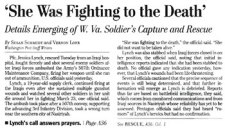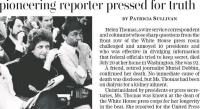Media Myth Alert revisits its top-ever posts today in observing its fifth anniversary.
The blog went live October 31, 2009, and its objective was, and remains, twofold: Calling out the appearance and publication of media myths and helping to promote Getting It Wrong, my media mythbusting book that came out in 2010.
This is the second of a two-part review of the 10 top posts published at Media Myth Alert, home over the years to more than 640 essays and commentaries. The top posts shared these elements: All were about prominent topics, all received a fair amount of attention in the blogosphere and beyond, and all represented disclosures exclusive to Media Myth Alert.
■ Bra-burning in Toronto: Confirmed (posted February 19, 2011): It is sometimes said, erroneously, that bra-burning “never happened,” that such reports were little more than hostile exaggerations by journalists.
Bra-burning never occurred?
Not quite.
Credible, first-hand accounts are cited in Getting It Wrong that bras and other items were set afire, briefly, at a women’s liberation protest at Atlantic City during the 1968 Miss American pageant. And in Toronto in March 1979, a demonstration was capped by a bra-burning, intended as a way to attract media attention. A photograph of the Toronto bra-burning is at right.
I had not seen the photograph before it appeared in February 2011 with an article at the online site of London’s Guardian newspaper. I had doubts about its authenticity, given the periodic claims about no bras ever having been burned at a feminist protest.
The Toronto image, I thought at first, might have been faked — or unethically altered somehow.
Turns out that was not the case.
I tracked down one of the participants at the Toronto protest and she confirmed the bra-burning, saying by phone from Vancouver:
“The photo is authentic. Absolutely. It happened.”
The participant was Vicki Trerise, who appears at the far right in the photograph above.
The photograph shows a moment of demonstrative bra-burning, although Trerise said that “wasn’t a focal point” of the protest, which took place not far from Toronto’s City Hall.
The bra-burning came near the end of the demonstration, which was called to protest what the organizers said was an illogical report about rape, prepared by the Ontario Provincial Police. (The report said that of 337 rapes investigated, 140 were “unprovoked.” The report also said “promiscuity” was a factor in many rapes.)
Trerise said the demonstrators in Toronto were media-aware and “knew that if they burned a bra, someone would take their picture.”
Toronto newspapers the next day reported on the protest — but did not mention the bra-burning.
■ Maddow wrongly declares Pentagon ‘made up’ bogus tale about Jessica Lynch’s battlefield heroics (posted June 4, 2014): In commentary on her MSNBC program in June 2014, Rachel Maddow wrongly accused the Pentagon of having “made up” the bogus account of Jessica Lynch’s battlefield heroics early in the Iraq War.
Maddow offered no sourcing for her claim, made while revisiting at some length the hero-warrior tale about Lynch, an Army supply clerk thrust into international fame on April 3, 2003, in an electrifying, front-page story in the Washington Post.
The Post report cited otherwise unidentified “U.S. officials” and declared that Lynch, a 19-year-old Army private, had fought fiercely in the ambush of her unit, the 507th Maintenance Company, in Nasiriyah in southern Iraq on March 23, 2003. Lynch suffered severe injuries in the crash of a Humvee in Nasiriyah. She was taken prisoner by the Iraqis but rescued by U.S. special forces on April 1, 2003.
Vernon Loeb, one of the Post reporters on the hero-warrior story — which was wrong in its important details — later made clear that the Pentagon had not been the newspaper’s source.
As I noted in Getting It Wrong, Loeb went on NPR’s Fresh Air program in December 2003 and declared, unequivocally:
“Our sources for that story were not Pentagon sources.”
None of that vital context was acknowledged by Maddow as she discussed the Lynch case on June 3, 2014.
“If the heroics that the Pentagon made up about her didn’t really happen, and they didn’t, maybe the U.S. special forces who rescued her, maybe they shouldn’t have bothered,” Maddow said about Lynch. (Maddow’s commentary was inspired by controversy surrounding the release a few days before of Bowe Bergdahl, an Army sergeant who apparently had walked away from his post in Afghanistan and was held captive by the Taliban for five years. The administration of President Barack Obama released five senior Taliban figures to gain Bergdahl’s freedom.)
When Maddow was called out on her erroneous claim about the Pentagon, she dodged a correction by cherry-picking — by referring to an obscure report in the Military Times on April 3, 2003, in which a military spokesman, Frank Thorp, was quoted as saying that Lynch “waged quite a battle prior to her capture.
“We do have very strong indications that Jessica Lynch was not captured very easily,” Thorp was additionally quoted as saying.
Crowed Maddow: “That information straight from a military public affairs official was not true. It was made up. But it landed in press reports anyway.”
What Maddow neglected to mention was that Thorp was recapping for the Military Times what the Washington Post had already published.
Thorp, then a Navy captain assigned to U.S. Central Command headquarters in Doha, Qatar, was not inventing — he was following. He was, unwisely, restating elements of the Post’s story already in circulation and quickly gaining international attention.
I wrote in discussing Maddow’s cherry-picking that “it is impossible to address the hero-warrior tale about Lynch without considering the Washington Post’s central and decisive role in the story.” But Maddow ignored the Post’s exclusive role in pushing the botched Lynch story into the public domain.
The Post did so by relying on sources it has never disclosed.
It ought to.
■ Digitally scrubbing WaPo’s embarrassment on Jessica Lynch? (posted April 27, 2012): The Washington Post’s Watergate content from the 1970s is freely available and readily accessible online.
But try finding online the Post’s famously wrong reporting about Jessica Lynch’s derring-do in Iraq, notably the electrifying front-page report that appeared April 3, 2003, beneath the headline:
“‘She was fighting to the death.'”
 That story — which said Lynch had fought fiercely against Iraqi attackers and had suffered gunshot and stab wounds before running out of ammunition and being taken prisoner — was in error in all important details. You won’t find it online at any Washington Post site. (The Post’s story is available in full at the online site of the Pittsburgh Post-Gazette.)
That story — which said Lynch had fought fiercely against Iraqi attackers and had suffered gunshot and stab wounds before running out of ammunition and being taken prisoner — was in error in all important details. You won’t find it online at any Washington Post site. (The Post’s story is available in full at the online site of the Pittsburgh Post-Gazette.)
Nor will you find freely available online the scathing reviews of the Lynch story published by the Post’s then-ombudsman, Michael Getler, in April and June 2003.
All of which suggests digital scrubbing of embarrassing content — conduct of the sort the Post criticized in 2012, in noting that Vogue magazine expunged the online version of a fawning profile of Syrian dictator Bashar al-Assad. The Post at that time said Vogue had taken “an almost-unheard-of step for a mainstream media organization” and had committed “a generally acknowledged violation of digital etiquette.”
But had the Post not committed a similar “violation” in excising the digital reminders of the embarrassing Lynch case, a dramatic story that it had thoroughly and exclusively botched?
Rather looks like it.
I asked the newspaper’s then-ombudsman, Patrick Pexton, about the apparent digital scrubbing of the Lynch content.
Pexton took weeks to reply, finally stating in an email that he had found “nothing nefarious about this.” He said the Post since 2003 “has gone through several changes of content management systems,” by which articles are posted online.
He noted that the “fighting to the death” story about Lynch and related content are available in the Post’s fee-based archive.
But why not make the “fighting to the death” story freely available? Why not remove the fee to allow access to a singularly memorable article of the Iraq War, a mistaken report that made Jessica Lynch something of a celebrity and gave rise to persistent and misguided claims and suspicions that the U.S. military concocted the hero-warrior tale and somehow fed it to the Post?
“Restoring the digital version of the article of April 3, 2003, would represent a contribution to the record about the case of Jessica Lynch, which the Post is solely responsible for having placed in the public domain,” I wrote in an email to Pexton.
He never replied before leaving the position in 2013, when his two-year term as ombudsman expired. He was not replaced.
■ George Romney’s “brainwashing” — and Gene McCarthy’s retort (posted September 4, 2012): Mitt Romney’s ill-fated run for the presidency in 2012 prompted reminders of his father’s failed presidential campaign in 1968 — a campaign memorable for an astonishingly clumsy gaffe.
The gaffe, in turn, is said to have inspired one of the most scathing putdowns in American political history.
But my research found that the context of the supposed putdown is unclear at best.
The gaffe was committed in late August 1967 by George Romney, then governor of Michigan and a presumptive leading candidate for the Republican presidential nomination in 1968.
In an interview with a Detroit television reporter, Romney referred to a visit he had made to South Vietnam in 1965 and said:
“You know, when I came back from Vietnam, I’d just had the greatest brainwashing that anybody could get. … Well, not only by the generals but by the diplomatic corps over there. They do a very thorough job.”
Romney’s claim that he had been duped into supporting America’s war effort in Vietnam suggested gullibility, muddled thinking, and an uncertain command of foreign policy. His run for the presidency never righted itself; he quit the race at the end of February 1968.
A witty putdown attributed to Democratic Senator Eugene McCarthy ensured that Romney’s gaffe would remain unforgettable. Rather than a “brainwashing,” McCarthy supposedly said, all Romney needed was a “light rinse.”
So incisive was McCarthy’s quip that it is said to have “essentially finished Romney” as a candidate for president.
But unclear is where, when, and even whether McCarthy made the “light rinse” comment.
A search of a full-text database of leading U.S. newspapers — including the New York Times, the Washington Post, Chicago Tribune, Los Angeles Times, and Baltimore Sun — turned up no published reference to the “light rinse” quip in 1967 or 1968. Or for years afterward. (The first reference was in 1983, a column in the Baltimore Sun that did not say when, where, or to whom McCarthy uttered the remark.)
It seems improbable that American journalists in 1967 or 1968 would have failed to report a retort as deft and delicious as McCarthy’s.
But that’s what An American Melodrama: The Presidential Campaign of 1968 claims.
American Melodrama, a hefty book published in 1969, described McCarthy’s remark as off-hand and said the senator’s aides persuaded reporters to hush it up.
While intriguing, American Melodrama doesn’t say where McCarthy made the comment, when, or specifically to whom.
Such vagueness invites suspicion about the “light rinse” quip. It also sounds a bit too perfect — not unlike, say, William Randolph Hearst’s purported vow to “furnish the war” with Spain or Lyndon B. Johnson’s supposed epiphany on the Vietnam War: “If I’ve lost Cronkite, I’ve lost Middle America.”
■ WaPo refuses to correct clear error on Nixon’s mythical ‘secret plan’ (posted August 13, 2013): Even in its clear decline, the Washington Post has moments of sheer arrogance.
This was apparent in late summer 2013, when the newspaper refused to acknowledge and correct an inarguably erroneous reference to Richard Nixon’s supposed “secret plan” to end the war in Vietnam.
The wrong-headed reference to Nixon’s “secret plan” was embedded in the Post’s front-page obituary about Helen Thomas, a querulous and overrated Washington journalist who covered the White House for years for United Press International.
The Post’s obituary was glowing and, as if to suggest Thomas’s impressive assertiveness, claimed that she once “asked President Richard M. Nixon point-blank what his secret plan to end the Vietnam War was.”
Trouble is, there is no evidence that Thomas ever posed such a question, point-blank or otherwise.
The nearest approximation came at a news conference in late January 1969, when Thomas asked Nixon about his “peace plan” for Vietnam. That’s probably what the obituary writer had in mind.
But Thomas had asked about Nixon’s peace plan, not a “secret plan.”
The Post’s error in the obituary had broader dimension, in that it suggested an embrace of the persistent notion that Nixon ran for president in 1968 touting a “secret plan” to end the war in Vietnam.
Which is untrue. Nixon did not campaign for the White House on a “secret plan.” The belief that he did circulates still, as supposedly powerful evidence of Nixon’s devious and conniving ways.
The obituary’s writer, Patricia Sullivan, said as much, telling me in response to an email query: “I recall the Nixon years and his promise during his candidacy that he had a plan to end the Vietnam War, which he would not explain in detail.”
In fact, Nixon was asked during the 1968 campaign about having a “secret plan” to end the war. And according to a report in the Los Angeles Times on March 28, 1968, he replied that he had “no gimmicks or secret plans.”
He also said: “If I had any way to end the war, I would pass it on to President [Lyndon] Johnson.”
I brought all this to the attention of Douglas Feaver, who had been designated the Post’s reader representative, a sort of ombudsman-lite position set up months after Pexton’s departure.
I noted to Feaver that if the Post could identify an occasion when Thomas asked Nixon about a “secret plan” on Vietnam — if the newspaper could back up the claim in its obituary, in other words — then that would represent an intriguing if modest contribution to the understanding about Nixon’s campaign in 1968. It would indicate that journalists at the time suspected Nixon was less than forthcoming about his intended war policy.
If, on the other hand, the Post could not identify such an occasion, then, I wrote, a correction was in order.
Feaver took more than two weeks to reply to my query, and when he did, he absolved the Post of error. “I see nothing here that deserves a correction,” he wrote.
How obtuse.
Coincidentally, not long after the Post published its flawed obituary about Thomas, the newspaper was sold for $250 million to Jeff Bezos, founder of Amazon.com. In an open letter to the newspaper’s employees soon after the sale was announced, Bezos stated:
“We will continue to follow the truth wherever it leads, and we’ll work hard not to make mistakes. When we do, we will own up to them quickly and completely.”
Sure: Quickly and completely. Just as it did in its mistaken reference to Nixon’s “secret plan.”
Other memorable posts at Media Myth Alert:
- No, Politico, Hearst did not cause the Spanish-American War
- Wikileaks and the Spanish-American War?
- Bill Clinton: Overstating social media influence in regime change
- Twain’s famous 1897 quote: The back story
- Just what we need: Barbra Streisand, media critic
- Jimmy Carter fumbles Watergate history
- Media history with Olbermann: Wrong and wrong
- Palin’s new book invokes bra-burning stereotype
- ‘Getting It Wrong’ goes on Q-and-A
- Check out The 1995 blog




[…] Five years on: The best of Media Myth Alert, Part II […]
[…] Five years on: The best of Media Myth Alert, Part II […]
[…] Five years on: The best of Media Myth Alert, Part II […]